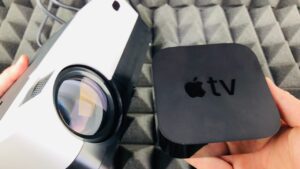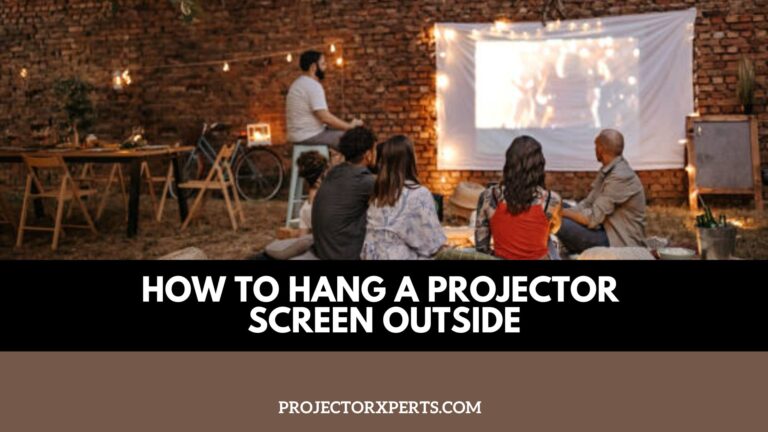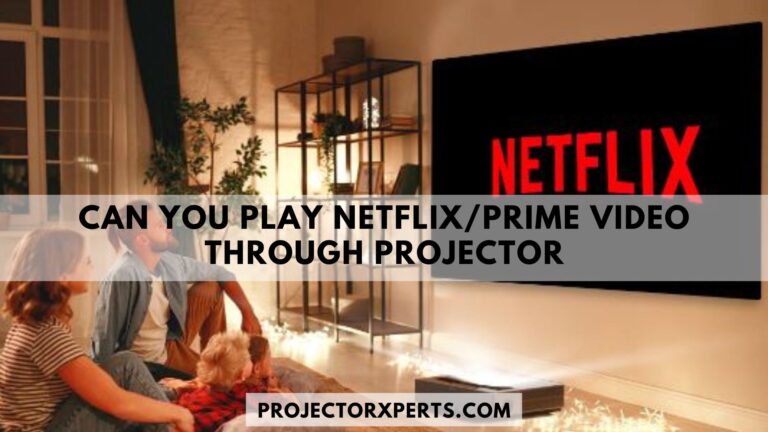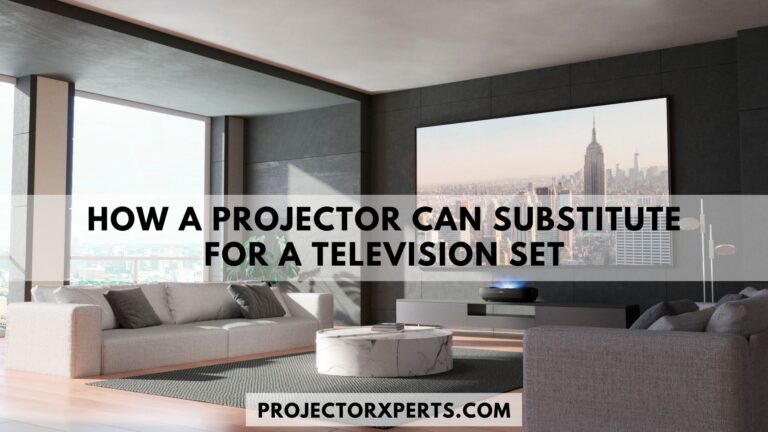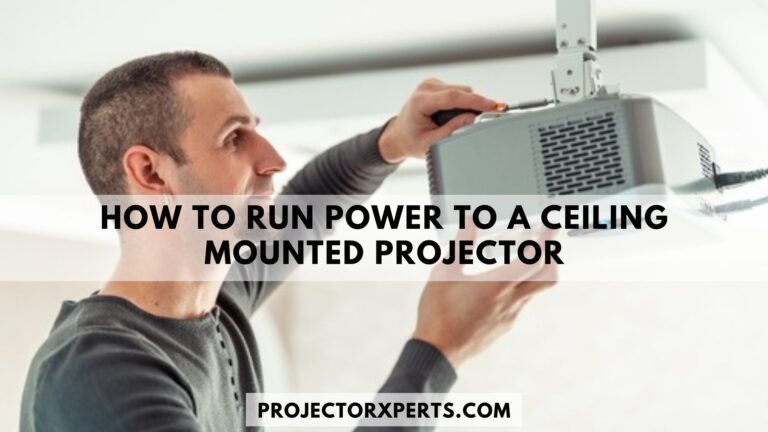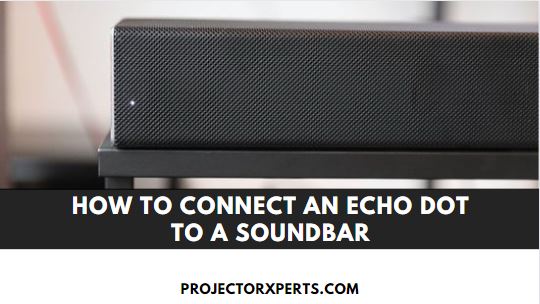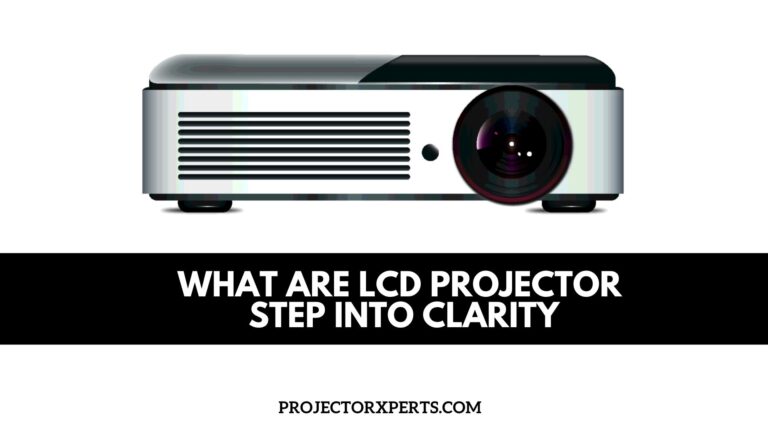How Can I Watch TV on My Projector?
Projectors display images or video on a larger screen. It works by receiving an input signal, typically from a computer, DVD player, or in this case, a TV. The projector then projects the content onto a wall or a projector screen, allowing you to enjoy a bigger and more immersive viewing experience.
Watching TV on a projector can be a game-changer for your home entertainment setup. It offers a cinematic experience, making everything larger than life. Whether you want to watch your favorite TV shows, sports events, or movies, a projector can provide stunning visuals with the potential for a massive screen size, far beyond what a traditional TV can offer. It’s perfect for movie nights with family and friends or for creating a theater-like experience right in your living room.
Connecting TV to Projector
Check Projector Compatibility
Before connecting your TV to the projector, ensure that the projector has the necessary input ports to support your TV’s output. Most projectors have HDMI, VGA, or composite video inputs. If your TV and projector have matching ports, you’re good to go. If not, you may need to purchase an appropriate adapter.
Selecting the Right Cables
Choosing the right cables is crucial for a seamless connection between your TV and projector. HDMI cables are the most common and widely used as they transmit both high-definition video and audio signals. Ensure you use a high-quality HDMI cable to avoid signal loss and degradation.
HDMI Connection
To connect your TV to the projector via HDMI, simply plug one end of the HDMI cable into the HDMI output port of your TV and the other end into the HDMI input port of the projector. Once connected, switch on both devices and select the HDMI input on the projector to start enjoying your TV content on the big screen.
Adjusting Projector Settings
Aspect Ratio and Resolution
After connecting the TV to the projector, you might need to adjust the aspect ratio and resolution settings to ensure that the content is displayed correctly. Most modern projectors can automatically detect the input signal and adjust the settings accordingly. However, it’s always a good idea to double-check and make manual adjustments if needed.
Keystone Correction
Keystone correction is essential for maintaining a proportionate and distortion-free image when the projector is placed at an angle rather than directly facing the screen. Many projectors come with keystone correction features that allow you to adjust the image and correct any trapezoidal distortion caused by the angle.
Screen Size and Distance
The screen size and distance between the projector and the screen play a vital role in your viewing experience. The further the projector is from the screen, the larger the image will be. Experiment with the distance to find the perfect screen size for your setup. Additionally, most projectors have a zoom function that allows you to adjust the image size without moving the projector physically.
Setting Up Audio
External Speakers
While projectors can display impressive visuals, they might not always provide the best audio experience. For a complete home theater experience, consider connecting external speakers to the projector. You can use speakers with a 3.5mm audio jack, Bluetooth capability, or by using the projector’s audio output ports.
Audio Output Options
Projectors typically have various audio output options, such as a 3.5mm audio jack, RCA, or optical audio output. Choose the one that matches the audio input of your external speakers. Some projectors also have built-in speakers, but for a more immersive experience, external speakers are recommended.
Streaming TV on a Projector
Using Streaming Devices
Streaming devices like Roku, Apple TV, Chromecast, or Amazon Fire TV Stick can be connected to your projector’s HDMI input. These devices allow you to access streaming services like Netflix, Hulu, or Disney+, giving you a wide range of content to enjoy on your projector.
Smart Projectors
Alternatively, you can opt for a smart projector that comes with built-in streaming capabilities. Smart projectors often have Wi-Fi connectivity and pre-installed apps, eliminating the need for external streaming devices. With a smart projector, you can directly access popular streaming platforms and even browse the internet from your projector.
Using Cable/Satellite TV
Connect via Set-Top Box
If you have a cable or satellite TV subscription, you can connect the set-top box to your projector using HDMI or other compatible cables. This allows you to watch live TV channels and access premium content just as you would on a regular television.
Using TV Tuner
Some projectors come with a built-in TV tuner, which allows you to connect an antenna and access free-to-air TV channels. This option is especially useful if you want to enjoy local channels and live broadcasts without the need for a cable or satellite subscription.
Troubleshooting Common Issues
No Signal Problems
If you encounter a “No Signal” message on your projector, double-check the cable connections between the TV and the projector. Ensure that both devices are powered on and set to the correct input source. If using HDMI, try a different cable or check if the HDMI ports are functional.
Audio and Video Sync Issues
Sometimes, you may notice a slight delay between the audio and video when using external speakers. To fix this, adjust the audio delay settings on your projector or the audio output settings on your TV or external speaker system until the audio and video sync up perfectly.
Tips for a Better Viewing Experience
Lighting Conditions
Consider the lighting conditions in the room where you’re using the projector. For the best image quality, it’s best to dim the lights or use blackout curtains to reduce ambient light. A darker room enhances the projector’s brightness and improves contrast, resulting in a more enjoyable viewing experience.
Ambient Noise Management
Projectors can generate some noise during operation, especially when using built-in fans for cooling. To minimize distractions, place the projector at a suitable distance from your seating area and use external speakers with ample volume to mask any projector noise.
Related:
FAQs About How to Watch TV on My Projector
Can I connect my TV to any type of projector?
Most modern TVs can be connected to projectors, but it’s essential to check compatibility. Look for matching input ports, like HDMI, and ensure your projector supports your TV’s output.
What cables do I need to connect my TV to the projector?
HDMI cables are the most common choice for connecting a TV to a projector. However, you may need adapters if your devices have different ports.
How do I adjust the projector’s settings for TV viewing?
You may need to tweak the aspect ratio, resolution, and keystone correction settings on your projector. Consult your projector’s manual for detailed instructions.
Can I use external speakers with my projector for better audio?
Yes, using external speakers can enhance your audio experience when watching TV on a projector. Most projectors have audio output options for this purpose.
What are smart projectors, and do I need one for TV viewing?
Smart projectors come with built-in streaming capabilities and apps. While not essential, they can simplify the TV-watching experience by eliminating the need for external streaming devices.
How can I watch cable or satellite TV on my projector?
You can connect your cable or satellite set-top box to your projector using HDMI or other compatible cables. Some projectors even have built-in TV tuners for free-to-air channels.
What should I do if I encounter a ‘No Signal’ error on my projector?
Check cable connections, ensure both devices are powered on, and select the correct input source on your projector. If using HDMI, try a different cable or port.
How can I optimize the viewing experience with my projector?
Consider controlling ambient lighting, using blackout curtains, and managing noise levels to enhance your projector TV experience.
Are projectors suitable for daytime TV viewing?
Projectors work best in dimly lit or dark rooms. While they can be used during the day, the image quality may not be as vibrant as in darker settings.
Can I watch TV shows and movies in 3D on a projector?
Some projectors support 3D content, but you’ll need compatible 3D glasses and 3D content sources to enjoy this feature.
Conclusion:
Watching TV on a projector can transform your entertainment experience at home. With the right connections, settings, and audio setup, you can enjoy your favorite TV shows and movies on a much larger screen. Whether you’re using streaming devices, smart projectors, or traditional cable/satellite connections, the key is to optimize the setup to suit your preferences and create a personalized, immersive viewing experience that rivals a movie theater right in the comfort of your own space. Experiment with different settings and enjoy your TV content in a whole new way with your projector.

